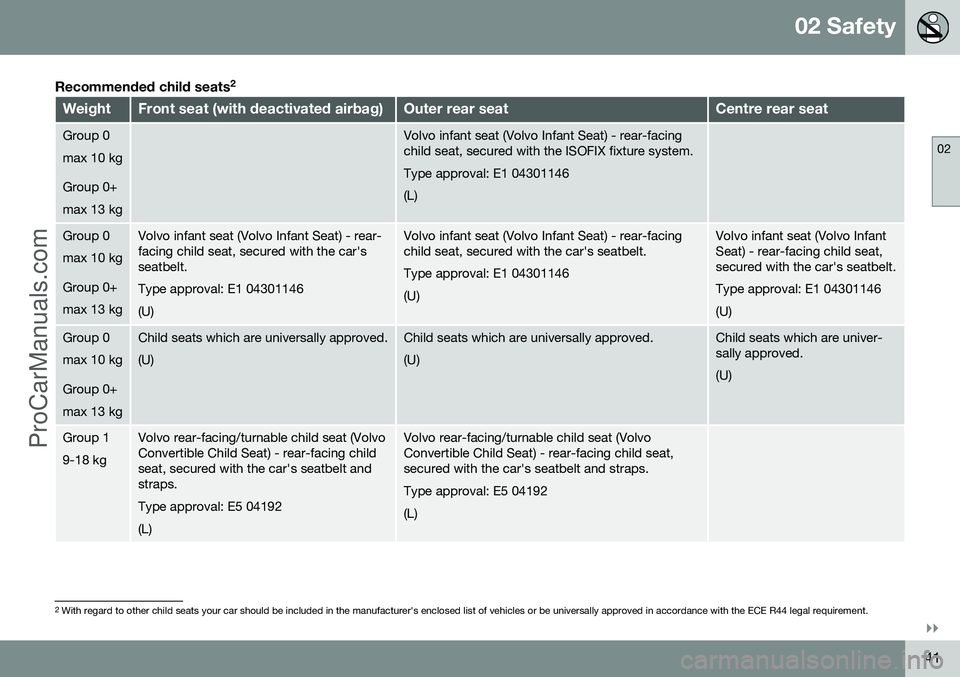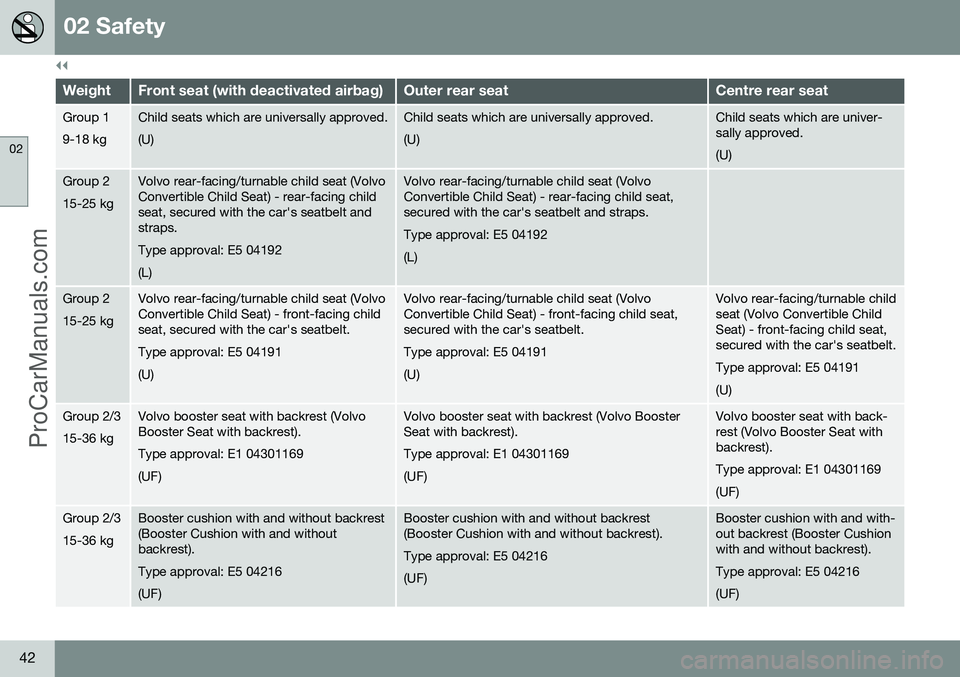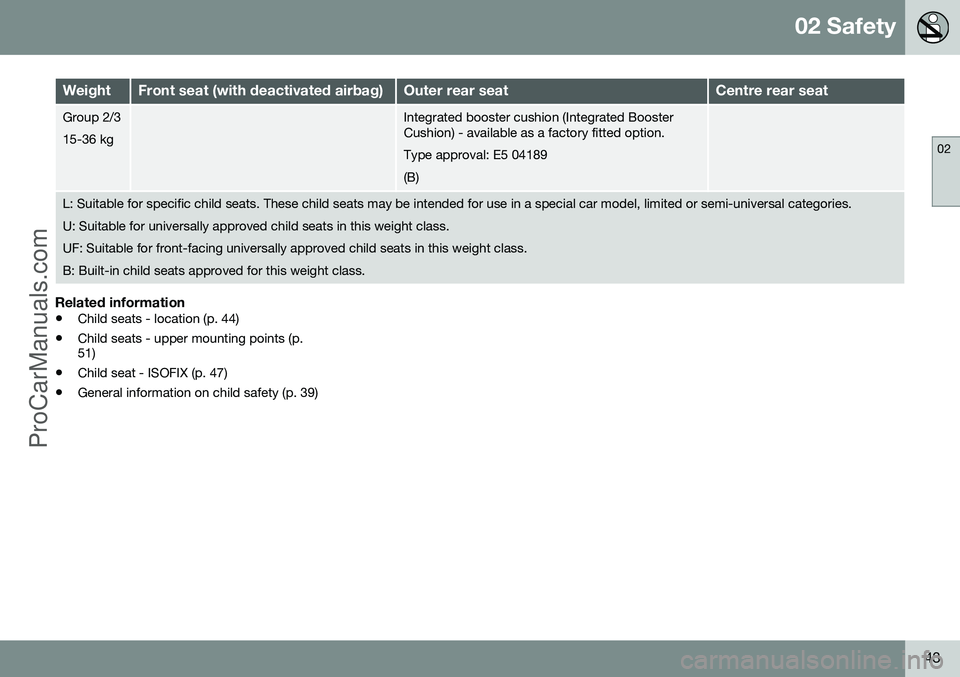2014 VOLVO V60 deactivate airbag
[x] Cancel search: deactivate airbagPage 32 of 442

02 Safety
02
30* Option/accessory, for more information, see Introduction.
Passenger airbag - activating/ deactivating*
Front passenger airbag (p. 29) can be deacti- vated if the car is equipped with a switch,PACOS (Passenger Airbag Cut Off Switch).
Switch - PACOSThe switch for the passenger airbag (PACOS)is located on the passenger end of the instru-ment panel and is accessible when the pas-senger door is open. Check that the switch is in the required posi- tion. The remote control key's key blade (p.155) should be used to change position.
Location of airbag label plus switch.
The airbag is activated. With the switch in this position, persons taller than 140 cmcan sit in the front passenger seat, but never children in a child seat or on abooster cushion.
The airbag is deactivated. With the switch in this position, children in a child seat oron a booster cushion can sit in the frontpassenger seat, but never persons tallerthan 140 cm.
WARNING
Activated airbag
(passenger seat):
Never place a child in a child seat or on a booster cushion on the front passengerseat when the airbag is activated. Thisapplies to everyone shorter than 140 cm. Deactivated airbag (passenger seat):
No one taller than 140 cm should ever sit in the front passenger seat when the air-bag is deactivated. Failure to follow the advice given above can endanger life.
NOTE
When the remote control key is in key position II (p. 70) the warning symbol (p.
27) for the airbag is shown in the com-bined instrument panel forapprox. 6 seconds. Following which, the indicator in the roof console is illuminated showing the correctstatus for the front passenger seat airbag.
G017800
Indicator showing that the passenger airbag is activated.
A warning symbol in the roof console indi- cates that the airbag for the front passengerseat is activated (see preceding illustration).
WARNING
Never place a child in a child seat or on a booster cushion in the front seat if the air- bag is activated and the symbol
in
the roof console is illuminated. Failure to follow this advice could endanger the lifeof the child.
ProCarManuals.co’
Page 33 of 442

02 Safety
02
31
2
2
G017724
Indicator showing that the passenger airbag is deactivated.
A text message and a symbol in the roof con- sole indicate that the airbag for the front pas-senger seat is deactivated (see precedingillustration).
WARNING
Do not allow anyone to sit in the front pas- senger seat if the message in the roof con-sole indicates that the airbag is deacti-vated, and if the warning symbol(p. 27) forthe airbag system is also displayed on thecombined instrument panel. This indicatesthat there has been a severe malfunction.Visit a workshop as soon as possible.Volvo recommends that you contact anauthorised Volvo workshop.
WARNING
Failure to follow the advice given above can endanger the lives of passengers inthe car.
Related information
• Child seats (p. 40)
Side airbag (SIPS)
In a side impact collision a large proportion of the collision force is transferred by the SIPS(Side Impact Protection System) to beams,pillars, the floor, the roof and other structuralparts of the body. The side airbags at the driv-er's and front passenger seats protect thechest area and the hip and are an importantpart of the SIPS.
G032949
The SIPS bag system consists of two main components, side airbag and sensors. Theside airbags are located in the front seatbackrests. A sufficiently violent collision trips the sensors and the side airbags are inflated. The airbaginflates between the occupant and the doorpanel and thereby cushions the initial impact.The airbag deflates when compressed by thecollision. The side airbag is normally onlydeployed on the side of the collision.
ProCarManuals.co’
Page 43 of 442

02 Safety
02
}}
41
Recommended child seats2
WeightFront seat (with deactivated airbag)Outer rear seatCentre rear seat
Group 0 max 10 kg Group 0+ max 13 kgVolvo infant seat (Volvo Infant Seat) - rear-facing child seat, secured with the ISOFIX fixture system. Type approval: E1 04301146(L)
Group 0 max 10 kg Group 0+ max 13 kgVolvo infant seat (Volvo Infant Seat) - rear- facing child seat, secured with the car'sseatbelt. Type approval: E1 04301146(U)Volvo infant seat (Volvo Infant Seat) - rear-facing child seat, secured with the car's seatbelt. Type approval: E1 04301146(U)Volvo infant seat (Volvo Infant Seat) - rear-facing child seat,secured with the car's seatbelt. Type approval: E1 04301146(U)
Group 0 max 10 kg Group 0+ max 13 kgChild seats which are universally approved. (U)Child seats which are universally approved. (U)Child seats which are univer- sally approved. (U)
Group 1 9-18 kgVolvo rear-facing/turnable child seat (Volvo Convertible Child Seat) - rear-facing childseat, secured with the car's seatbelt andstraps. Type approval: E5 04192(L)Volvo rear-facing/turnable child seat (Volvo Convertible Child Seat) - rear-facing child seat,secured with the car's seatbelt and straps. Type approval: E5 04192(L)
2
With regard to other child seats your car should be included in the manufacturer's enclosed list of vehicles or be universally approved in accordance with the ECE R44 legal requirement.
ProCarManuals.co’
Page 44 of 442

||
02 Safety
02
42
WeightFront seat (with deactivated airbag)Outer rear seatCentre rear seat
Group 1 9-18 kgChild seats which are universally approved. (U)Child seats which are universally approved. (U)Child seats which are univer- sally approved. (U)
Group 2 15-25 kgVolvo rear-facing/turnable child seat (Volvo Convertible Child Seat) - rear-facing childseat, secured with the car's seatbelt andstraps. Type approval: E5 04192(L)Volvo rear-facing/turnable child seat (Volvo Convertible Child Seat) - rear-facing child seat,secured with the car's seatbelt and straps. Type approval: E5 04192(L)
Group 2 15-25 kgVolvo rear-facing/turnable child seat (Volvo Convertible Child Seat) - front-facing childseat, secured with the car's seatbelt. Type approval: E5 04191(U)Volvo rear-facing/turnable child seat (Volvo Convertible Child Seat) - front-facing child seat,secured with the car's seatbelt. Type approval: E5 04191(U)Volvo rear-facing/turnable child seat (Volvo Convertible ChildSeat) - front-facing child seat,secured with the car's seatbelt. Type approval: E5 04191(U)
Group 2/3 15-36 kgVolvo booster seat with backrest (Volvo Booster Seat with backrest). Type approval: E1 04301169(UF)Volvo booster seat with backrest (Volvo Booster Seat with backrest). Type approval: E1 04301169(UF)Volvo booster seat with back- rest (Volvo Booster Seat withbackrest). Type approval: E1 04301169(UF)
Group 2/3 15-36 kgBooster cushion with and without backrest (Booster Cushion with and withoutbackrest). Type approval: E5 04216(UF)Booster cushion with and without backrest (Booster Cushion with and without backrest). Type approval: E5 04216(UF)Booster cushion with and with- out backrest (Booster Cushionwith and without backrest). Type approval: E5 04216(UF)
ProCarManuals.co’
Page 45 of 442

02 Safety
02
43
WeightFront seat (with deactivated airbag)Outer rear seatCentre rear seat
Group 2/3 15-36 kgIntegrated booster cushion (Integrated Booster Cushion) - available as a factory fitted option. Type approval: E5 04189(B)
L: Suitable for specific child seats. These child seats may be intended for use in a special car model, limited or semi-universal categories. U: Suitable for universally approved child seats in this weight class.UF: Suitable for front-facing universally approved child seats in this weight class.B: Built-in child seats approved for this weight class.
Related information
•Child seats - location (p. 44)
• Child seats - upper mounting points (p. 51)
• Child seat - ISOFIX (p. 47)
• General information on child safety (p. 39)
ProCarManuals.co’
Page 157 of 442

06 Locks and alarm
06
* Option/accessory, for more information, see Introduction.155
Detachable key blade
A remote control key (p. 149) contains a detachable key blade of metal with whichsome functions can be activated and someoperations carried out. The key blade's unique code is provided by authorised Volvo workshops, which are rec-ommended when ordering new key blades.
Key blade functionsUsing the remote control key's detachablekey blade:
• the left-hand front door can be opened manually if central locking cannot be acti-vated with the remote control key, seeDetachable key blade - unlocking doors(p. 156).
• the rear doors' mechanical child safetylocks can be activated/deactivated (p.169).
• the right-hand front door and the reardoors can be locked manually (p. 165),e.g. in the event of power failure.
• access to the glovebox and cargo area(privacy locking (p. 156)*) can beblocked.
• the airbag for front passenger seat(PACOS*) can be activated/deactivated(p. 30).
Related information
•Remote control key - functions (p. 151)
• Remote control key with key blade (p.149)
Detachable key blade - detaching/ attaching
Detaching/attaching the detachable key blade (p. 155) is carried out as follows:
Removing the key blade
Slide the spring-loaded catch to the side.
At the same time pull the key blade straight out backwards.
Attaching the key bladeCarefully refit the key blade into its location inthe remote control key (p. 149).
1. Hold the remote control key with the slot
pointed up and lower the key blade into its slot.
2. Lightly press the key blade. You should hear a "click" when the key blade islocked in.
ProCarManuals.co’
Page 158 of 442

||
06 Locks and alarm
06
156* Option/accessory, for more information, see Introduction.
Related information
• Detachable key blade - unlocking doors (p. 156)
• Child safety locks - manual activation (p.169)
• Passenger airbag - activating/deactivat-ing* (p. 30)
Detachable key blade - unlocking doors
The detachable key blade (p. 155) can be used if central locking cannot be activatedwith the remote control key (p. 149), e.g. if thekey's battery has run out. If central locking cannot be activated with the remote control key - e.g. if the batteries aredischarged - then the left-hand front door canbe opened as follows:
1. Unlock the left-hand front door with the
key blade in the door handle's lock cylin- der. For illustration and more information,see Keyless drive* - unlocking with thekey blade (p. 162).
NOTE
When the door has been unlocked using the key blade and is opened, the alarm istriggered.
2. Deactivate the alarm by inserting theremote control key in the ignition switch.
For cars with the Keyless system, see Keyless drive* - unlocking with the key blade(p. 162).
Related information
• Remote control key with key blade (p. 149)
• Remote control key/PCC - replacing thebattery (p. 158)
Privacy locking*
Privacy locking is intended for when the car is left for service, with a hotel parking valet orsimilar. The glovebox is then locked and thetailgate lock is disconnected from the centrallocking - the tailgate cannot be opened witheither the central locking button in the frontdoors or the remote control key (p. 149).
G017869
Active locks for remote control key
with key
blade.
ProCarManuals.com
Page 316 of 442

||
08 Starting and driving
08
314
WARNING
•Check that the steering lock is unlocked before towing.
• The remote control key must be in keyposition
II - in position I all airbags are
deactivated.
• Never remove the remote control keyfrom the ignition switch when the caris being towed.
WARNING
The brake servo and power steering do not work when the engine is switched off - thebrake pedal needs to be depressedabout 5 times more heavily and the steer-ing is considerably heavier than normal.
Manual gearboxPrior to towing:
–Move gear lever into neutral and release the parking brake.
Automatic gearbox GeartronicPrior to towing:
–Move the gear selector to position
N and
release the parking brake.
Automatic gearbox PowershiftThe model with Powershift transmission should not be towed as it is dependent on theengine running in order to receive sufficient lubrication. If towing still has to take place,the route must be as short as possible andthen with very low speed. In the event of uncertainty as to whether or not the car is equipped with Powershift trans-mission, this can be verified by checking thedesignation on the gearbox label under thebonnet, see Type designations (p. 386). Thedesignation ”MPS6” means that it isPowershift transmission - otherwise it isGeartronic automatic transmission.
IMPORTANT
Avoid towing.
• However, the car can be towed for a short distance at low speed to move itfrom a dangerous position - not furtherthan 10 km and not faster than10 km/h. Note that the car mustalways be towed with the wheels roll-ing forward.
• In the event of moving a longer dis-tance than 10 km, the car must betransported with the drive wheelsraised from the road - professionalrecovery is recommended.
Prior to towing:
–Move the gear selector to position
N and
release the parking brake.
Jump startingDo not tow the car to bump start the engine. Use a donor battery if the battery is dis-charged and the engine does not start, seeJump starting with battery (p. 270).
IMPORTANT
The catalytic converter may be damaged during attempts to tow-start the engine.
Related information
• Towing eye (p. 315)
ProCarManuals.co’